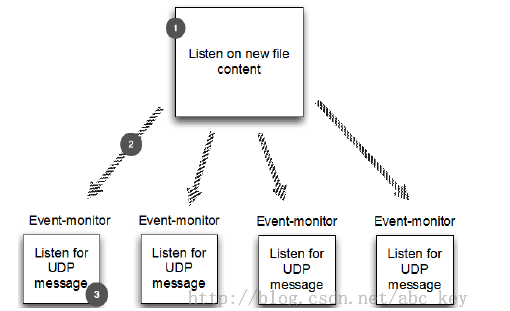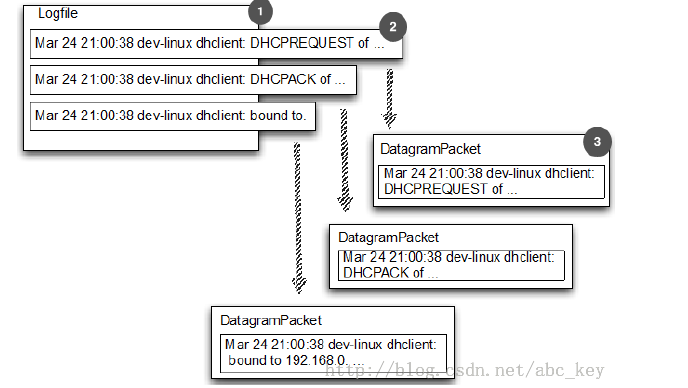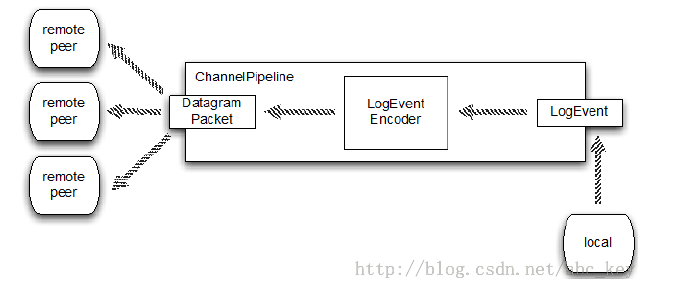第十三章:通过UDP广播事件
2016-09-27 00:00
519 查看
本章介绍
UDP介绍
UDP程序结构和设计
日志事件POJO
编写广播器
编写监听者
使用广播器和监听者
Summary
前面的章节都是在示例中使用TCP协议,这一章,我们将使用UDP。UDP是一种无连接协议,若需要很高的性能和对数据的完成性没有严格要求,那使用UDP是一个很好的方法。最著名的基于UDP协议的是用来域名解析的DNS。
Netty使用了统一的传输API,这使得编写基于UDP的应用程序很容易。可以重用现有的ChannelHandler和其他公共组件来编写另外的Netty程序。看完本章后,你就会知道什么是无连接协议以及为什么UDP可能适合你的应用程序。
13.1 UDP介绍
在深入探讨UDP之前,我们先了解UDP是什么,以及UDP有什么限制或问题。UDP是一种无连接的协议,也就是说客户端和服务器在交互数据之前不会像TCP那样事先建立连接。
UDP是User Datagram Protocol的简称,即用户数据报协议。UDP有不提供数据报分组、组装和不能对数据报进行排序的缺点,也就是说,当数据报发送之后是无法确认数据是否完整到达的。
UDP协议的主要作用是将网络数据流量压缩成数据包的形式。一个典型的数据包就是一个二进制数据的传输单位。每一个数据包的前8个字节用来包含报头信息,剩余字节则用来包含具体的传输数据。
在选择使用协议的时候,选择UDP必须要谨慎。在网络质量令人十分不满意的环境下,UDP协议数据包丢失会比较严重。但是由于UDP的特性:它不属于连接型协议,因而具有资源消耗小,处理速度快的优点,所以通常音频、视频和普通数据在传送时使用UDP较多,因为它们即使偶尔丢失一两个数据包,也不会对接收结果产生太大影响。比如我们聊天用的ICQ和QQ就是使用的UDP协议。
13.2 UDP程序结构和设计
本章例子中,程序打开一个文件并将文件内容一行一行的通过UDP广播到其他的接收主机。
对于像发送日志的需求,UDP非常适合这样的应用程序,并可以使用UDP通过网络发送大量的“事件”。
每个UDP报文分UDP报头和UDP数据区两部分,报头由四个16位长(2字节)字段组成,分别说明该报文的源端口、目的端口、报文长度以及校验值;数据库就是传输的具体数据。
UDP有如下特性:
1.UDP是一个无连接协议,传输数据之前源端和终端不建立连接,当它想传送时就简单地去抓取来自应用程序的数据,并尽可能快地把它扔到网络上。在发送端,UDP传送数据的速度仅仅是受应用程序生成数据的速度、计算机的能力和传输带宽的限制;在接收端,UDP把每个消息段放在队列中,应用程序每次从队列中读一个消息段。
2.由于传输数据不建立连接,因此也就不需要维护连接状态,包括收发状态等,因此一台服务机可同时向多个客户机传输相同的消息。
3.UDP信息包的标题很短,只有8个字节,相对于TCP的20个字节信息包的额外开销很小。
4.吞吐量不受拥挤控制算法的调节,只受应用软件生成数据的速率、传输带宽、源端和终端主机性能的限制。
5.UDP使用尽最大努力交付,即不保证可靠交付,因此主机不需要维持复杂的链接状态表(这里面有许多参数)。
6.UDP是面向报文的。发送方的UDP对应用程序交下来的报文,在添加首部后就向下交付给IP层。既不拆分,也不合并,而是保留这些报文的边界,因此,应用程序需要选择合适的报文大小。
本章UDP程序例子的示意图入如下:

从上图可以看出,例子程序由两部分组成:广播日志文件和“监控器”,监控器用于接收广播。为了简单,我们将不做任何形式的身份验证或加密。
13.3 日志事件POJO
我们的应用程序通常需要某种“消息POJO”用于保存消息,我们把这个消息POJO看成是一个“事件消息”在本例子中我们也创建一个POJO叫做LogEvent,LogEvent用来存储事件数据,然后将数据输出到日志文件。看下面代码:
接下来的章节,我们将用这个POJO类来实现具体的逻辑。
13.4 编写广播器
我们要做的是广播一个DatagramPacket日志条目,如下图所示:

上图显示我们有一个从日志条路到DatagramPacket一对一的关系。如同所有的基于Netty的应用程序一样,它由一个或多个ChannelHandler和一些实体对象绑定,用于引导该应用程序。首先让我们来看看LogEventBroadcaster的ChannelPipeline以及作为数据载体的LogEvent的流向,看下图:

上图显示,LogEventBroadcaster使用LogEvent消息并将消息写入本地Channel,所有的信息封装在LogEvent消息中,这些消息被传到ChannelPipeline中。流进ChannelPipeline的LogEvent消息被编码成DatagramPacket消息,最后通过UDP广播到远程对等通道。
这可以归结为有一个自定义的ChannelHandler,从LogEvent消息编程成DatagramPacket消息。
回忆我们在第七章讲解的编解码器,我们定义个LogEventEncoder,代码如下:
下面我们再编写一个广播器:
13.5 编写监听者
这一节我们编写一个监听者:EventLogMonitor,也就是用来接收数据的程序。EventLogMonitor做下面事情:
接收LogEventBroadcaster广播的DatagramPacket
解码LogEvent消息
输出LogEvent
EventLogMonitor的示意图如下:

解码器代码如下:
处理消息的Handler代码如下:
EventLogMonitor代码如下:
13.6 使用LogEventBroadcaster和LogEventMonitor
为避免LogEventMonitor接收不到数据,我们必须先启动LogEventMonitor后,再启动LogEventBroadcaster,输出内容就不贴图了,读者可以自己运营本例子测试。
13.7 Summary
本章依然没按照原书中的来翻译,主要是以一个例子来说明UDP在Netty中的使用。概念性的东西都是从网上复制的,读者只需要了解UDP的概念再了解清楚例子代码的含义,并试着运行一些例子。
UDP介绍
UDP程序结构和设计
日志事件POJO
编写广播器
编写监听者
使用广播器和监听者
Summary
前面的章节都是在示例中使用TCP协议,这一章,我们将使用UDP。UDP是一种无连接协议,若需要很高的性能和对数据的完成性没有严格要求,那使用UDP是一个很好的方法。最著名的基于UDP协议的是用来域名解析的DNS。
Netty使用了统一的传输API,这使得编写基于UDP的应用程序很容易。可以重用现有的ChannelHandler和其他公共组件来编写另外的Netty程序。看完本章后,你就会知道什么是无连接协议以及为什么UDP可能适合你的应用程序。
13.1 UDP介绍
在深入探讨UDP之前,我们先了解UDP是什么,以及UDP有什么限制或问题。UDP是一种无连接的协议,也就是说客户端和服务器在交互数据之前不会像TCP那样事先建立连接。
UDP是User Datagram Protocol的简称,即用户数据报协议。UDP有不提供数据报分组、组装和不能对数据报进行排序的缺点,也就是说,当数据报发送之后是无法确认数据是否完整到达的。
UDP协议的主要作用是将网络数据流量压缩成数据包的形式。一个典型的数据包就是一个二进制数据的传输单位。每一个数据包的前8个字节用来包含报头信息,剩余字节则用来包含具体的传输数据。
在选择使用协议的时候,选择UDP必须要谨慎。在网络质量令人十分不满意的环境下,UDP协议数据包丢失会比较严重。但是由于UDP的特性:它不属于连接型协议,因而具有资源消耗小,处理速度快的优点,所以通常音频、视频和普通数据在传送时使用UDP较多,因为它们即使偶尔丢失一两个数据包,也不会对接收结果产生太大影响。比如我们聊天用的ICQ和QQ就是使用的UDP协议。
13.2 UDP程序结构和设计
本章例子中,程序打开一个文件并将文件内容一行一行的通过UDP广播到其他的接收主机。
对于像发送日志的需求,UDP非常适合这样的应用程序,并可以使用UDP通过网络发送大量的“事件”。
每个UDP报文分UDP报头和UDP数据区两部分,报头由四个16位长(2字节)字段组成,分别说明该报文的源端口、目的端口、报文长度以及校验值;数据库就是传输的具体数据。
UDP有如下特性:
1.UDP是一个无连接协议,传输数据之前源端和终端不建立连接,当它想传送时就简单地去抓取来自应用程序的数据,并尽可能快地把它扔到网络上。在发送端,UDP传送数据的速度仅仅是受应用程序生成数据的速度、计算机的能力和传输带宽的限制;在接收端,UDP把每个消息段放在队列中,应用程序每次从队列中读一个消息段。
2.由于传输数据不建立连接,因此也就不需要维护连接状态,包括收发状态等,因此一台服务机可同时向多个客户机传输相同的消息。
3.UDP信息包的标题很短,只有8个字节,相对于TCP的20个字节信息包的额外开销很小。
4.吞吐量不受拥挤控制算法的调节,只受应用软件生成数据的速率、传输带宽、源端和终端主机性能的限制。
5.UDP使用尽最大努力交付,即不保证可靠交付,因此主机不需要维持复杂的链接状态表(这里面有许多参数)。
6.UDP是面向报文的。发送方的UDP对应用程序交下来的报文,在添加首部后就向下交付给IP层。既不拆分,也不合并,而是保留这些报文的边界,因此,应用程序需要选择合适的报文大小。
本章UDP程序例子的示意图入如下:

从上图可以看出,例子程序由两部分组成:广播日志文件和“监控器”,监控器用于接收广播。为了简单,我们将不做任何形式的身份验证或加密。
13.3 日志事件POJO
我们的应用程序通常需要某种“消息POJO”用于保存消息,我们把这个消息POJO看成是一个“事件消息”在本例子中我们也创建一个POJO叫做LogEvent,LogEvent用来存储事件数据,然后将数据输出到日志文件。看下面代码:
package netty.in.action.udp;
import java.net.InetSocketAddress;
public class LogEvent {
public static final byte SEPARATOR = (byte) '|';
private final InetSocketAddress source;
private final String logfile;
private final String msg;
private final long received;
public LogEvent(String logfile, String msg) {
this(null, -1, logfile, msg);
}
public LogEvent(InetSocketAddress source, long received, String logfile, String msg) {
this.source = source;
this.logfile = logfile;
this.msg = msg;
this.received = received;
}
public InetSocketAddress getSource() {
return source;
}
public String getLogfile() {
return logfile;
}
public String getMsg() {
return msg;
}
public long getReceived() {
return received;
}
}接下来的章节,我们将用这个POJO类来实现具体的逻辑。
13.4 编写广播器
我们要做的是广播一个DatagramPacket日志条目,如下图所示:

上图显示我们有一个从日志条路到DatagramPacket一对一的关系。如同所有的基于Netty的应用程序一样,它由一个或多个ChannelHandler和一些实体对象绑定,用于引导该应用程序。首先让我们来看看LogEventBroadcaster的ChannelPipeline以及作为数据载体的LogEvent的流向,看下图:

上图显示,LogEventBroadcaster使用LogEvent消息并将消息写入本地Channel,所有的信息封装在LogEvent消息中,这些消息被传到ChannelPipeline中。流进ChannelPipeline的LogEvent消息被编码成DatagramPacket消息,最后通过UDP广播到远程对等通道。
这可以归结为有一个自定义的ChannelHandler,从LogEvent消息编程成DatagramPacket消息。
回忆我们在第七章讲解的编解码器,我们定义个LogEventEncoder,代码如下:
package netty.in.action.udp;
import io.netty.buffer.ByteBuf;
import io.netty.channel.ChannelHandlerContext;
import io.netty.channel.socket.DatagramPacket;
import io.netty.handler.codec.MessageToMessageEncoder;
import io.netty.util.CharsetUtil;
import java.net.InetSocketAddress;
import java.util.List;
public class LogEventEncoder extends MessageToMessageEncoder<LogEvent> {
private final InetSocketAddress remoteAddress;
public LogEventEncoder(InetSocketAddress remoteAddress){
this.remoteAddress = remoteAddress;
}
@Override
protected void encode(ChannelHandlerContext ctx, LogEvent msg, List<Object> out)
throws Exception {
ByteBuf buf = ctx.alloc().buffer();
buf.writeBytes(msg.getLogfile().getBytes(CharsetUtil.UTF_8));
buf.writeByte(LogEvent.SEPARATOR);
buf.writeBytes(msg.getMsg().getBytes(CharsetUtil.UTF_8));
out.add(new DatagramPacket(buf, remoteAddress));
}
}下面我们再编写一个广播器:
package netty.in.action.udp;
import io.netty.bootstrap.Bootstrap;
import io.netty.channel.Channel;
import io.netty.channel.ChannelOption;
import io.netty.channel.EventLoopGroup;
import io.netty.channel.nio.NioEventLoopGroup;
import io.netty.channel.socket.nio.NioDatagramChannel;
import java.io.File;
import java.io.IOException;
import java.io.RandomAccessFile;
import java.net.InetSocketAddress;
public class LogEventBroadcaster {
private final EventLoopGroup group;
private final Bootstrap bootstrap;
private final File file;
public LogEventBroadcaster(InetSocketAddress address, File file) {
group = new NioEventLoopGroup();
bootstrap = new Bootstrap();
bootstrap.group(group).channel(NioDatagramChannel.class)
.option(ChannelOption.SO_BROADCAST, true)
.handler(new LogEventEncoder(address));
this.file = file;
}
public void run() throws IOException {
Channel ch = bootstrap.bind(0).syncUninterruptibly().channel();
long pointer = 0;
for (;;) {
long len = file.length();
if (len < pointer) {
pointer = len;
} else {
RandomAccessFile raf = new RandomAccessFile(file, "r");
raf.seek(pointer);
String line;
while ((line = raf.readLine()) != null) {
ch.write(new LogEvent(null, -1, file.getAbsolutePath(), line));
}
ch.flush();
pointer = raf.getFilePointer();
raf.close();
}
try {
Thread.sleep(1000);
} catch (InterruptedException e) {
Thread.interrupted();
break;
}
}
}
public void stop() {
group.shutdownGracefully();
}
public static void main(String[] args) throws Exception {
int port = 4096;
String path = System.getProperty("user.dir") + "/log.txt";
LogEventBroadcaster broadcaster = new LogEventBroadcaster(new InetSocketAddress(
"255.255.255.255", port), new File(path));
try {
broadcaster.run();
} finally {
broadcaster.stop();
}
}
}13.5 编写监听者
这一节我们编写一个监听者:EventLogMonitor,也就是用来接收数据的程序。EventLogMonitor做下面事情:
接收LogEventBroadcaster广播的DatagramPacket
解码LogEvent消息
输出LogEvent
EventLogMonitor的示意图如下:

解码器代码如下:
package netty.in.action.udp;
import io.netty.buffer.ByteBuf;
import io.netty.channel.ChannelHandlerContext;
import io.netty.channel.socket.DatagramPacket;
import io.netty.handler.codec.MessageToMessageDecoder;
import io.netty.util.CharsetUtil;
import java.util.List;
public class LogEventDecoder extends MessageToMessageDecoder<DatagramPacket> {
@Override
protected void decode(ChannelHandlerContext ctx, DatagramPacket msg, List<Object> out)
throws Exception {
ByteBuf buf = msg.content();
int i = buf.indexOf(0, buf.readableBytes(), LogEvent.SEPARATOR);
String filename = buf.slice(0, i).toString(CharsetUtil.UTF_8);
String logMsg = buf.slice(i + 1, buf.readableBytes()).toString(CharsetUtil.UTF_8);
LogEvent event = new LogEvent(msg.sender(),
System.currentTimeMillis(), filename, logMsg);
out.add(event);
}
}处理消息的Handler代码如下:
package netty.in.action.udp;
import io.netty.channel.ChannelHandlerContext;
import io.netty.channel.SimpleChannelInboundHandler;
public class LogEventHandler extends SimpleChannelInboundHandler<LogEvent> {
@Override
protected void channelRead0(ChannelHandlerContext ctx, LogEvent msg) throws Exception {
StringBuilder builder = new StringBuilder();
builder.append(msg.getReceived());
builder.append(" [");
builder.append(msg.getSource().toString());
builder.append("] [");
builder.append(msg.getLogfile());
builder.append("] : ");
builder.append(msg.getMsg());
System.out.println(builder.toString());
}
}EventLogMonitor代码如下:
package netty.in.action.udp;
import io.netty.bootstrap.Bootstrap;
import io.netty.channel.Channel;
import io.netty.channel.ChannelInitializer;
import io.netty.channel.ChannelOption;
import io.netty.channel.ChannelPipeline;
import io.netty.channel.EventLoopGroup;
import io.netty.channel.nio.NioEventLoopGroup;
import io.netty.channel.socket.nio.NioDatagramChannel;
import java.net.InetSocketAddress;
public class LogEventMonitor {
private final EventLoopGroup group;
private final Bootstrap bootstrap;
public LogEventMonitor(InetSocketAddress address) {
group = new NioEventLoopGroup();
bootstrap = new Bootstrap();
bootstrap.group(group).channel(NioDatagramChannel.class)
.option(ChannelOption.SO_BROADCAST, true)
.handler(new ChannelInitializer<Channel>() {
@Override
protected void initChannel(Channel channel) throws Exception {
ChannelPipeline pipeline = channel.pipeline();
pipeline.addLast(new LogEventDecoder());
pipeline.addLast(new LogEventHandler());
}
}).localAddress(address);
}
public Channel bind() {
return bootstrap.bind().syncUninterruptibly().channel();
}
public void stop() {
group.shutdownGracefully();
}
public static void main(String[] args) throws InterruptedException {
LogEventMonitor monitor = new LogEventMonitor(new InetSocketAddress(4096));
try {
Channel channel = monitor.bind();
System.out.println("LogEventMonitor running");
channel.closeFuture().sync();
} finally {
monitor.stop();
}
}
}13.6 使用LogEventBroadcaster和LogEventMonitor
为避免LogEventMonitor接收不到数据,我们必须先启动LogEventMonitor后,再启动LogEventBroadcaster,输出内容就不贴图了,读者可以自己运营本例子测试。
13.7 Summary
本章依然没按照原书中的来翻译,主要是以一个例子来说明UDP在Netty中的使用。概念性的东西都是从网上复制的,读者只需要了解UDP的概念再了解清楚例子代码的含义,并试着运行一些例子。
相关文章推荐
- Netty In Action中文版 - 第十三章:通过UDP广播事件
- Netty In Action中文版 - 第十三章:通过UDP广播事件
- Netty In Action中文版 - 第十三章:通过UDP广播事件
- Netty In Action中文版 - 第十三章:通过UDP广播事件
- Netty In Action中文版 - 第十三章:通过UDP广播事件
- Netty In Action中文版 - 第十三章:通过UDP广播事件
- Netty In Action中文版 - 第十三章:通过UDP广播事件
- Netty In Action中文版 - 第十三章:通过UDP广播事件
- Netty In Action中文版 - 第十三章:通过UDP广播事件
- Netty In Action中文版 - 第十三章:通过UDP广播事件
- Netty In Action中文版 - 第十三章:通过UDP广播事件
- Netty In Action中文版 - 第十三章:通过UDP广播事件
- Netty In Action中文版 - 第十三章:通过UDP广播事件
- Netty In Action中文版 - 第十三章:通过UDP广播事件
- Netty In Action中文版 - 第十三章:通过UDP广播事件
- Netty In Action中文版 - 第十三章:通过UDP广播事件
- Netty In Action中文版 - 第十三章:通过UDP广播事件
- 第八篇:通过UDP广播事件
- 通过Windows API 接收 AMT UDP 广播的 Trap 事件
- 13 通过UDP广播事件
